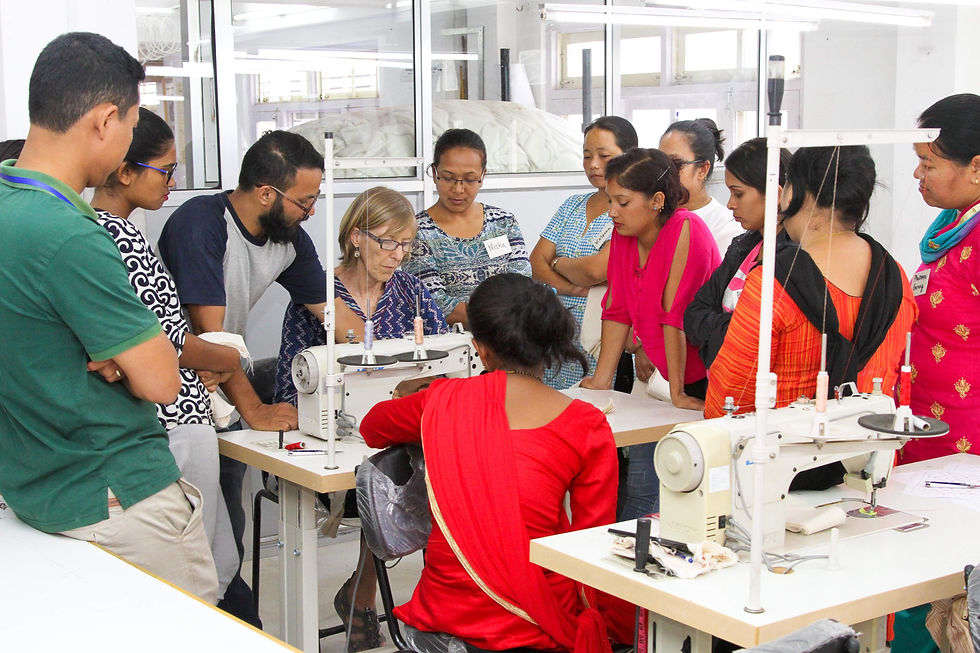How Purnaa’s Commitment to Continuous Improvement Helps You
- The Purnaa Team
- Nov 2, 2020
- 4 min read
An Interview with Master Trainer, Suzanne Allibone
By Alex Berryman

A great manufacturer is committed to continuous improvement and growing efficiency so they serve their customers with a better, faster, and cheaper service. This growth mindset has helped us, at Purnaa, to push and continually look for ways to improve our capabilities to fit each new customer's needs. Instead of sending a customer through a system that doesn't work for them (as many traditional cut and sew companies often do), we leverage our modest company size, pivoting the production process for new production runs and making necessary changes to fit the requirements of our customers. Here, we interview Purnaa’s Master Trainer, Suzanne Allibone, for a glimpse at her recent work helping grow efficiency and new capabilities within Purnaa’s Sampling and Production teams.

What aspects of sampling and production contribute to a strong production run?
There are so many things that can make or break a successful production run! At the moment we in the Sample Team are focusing on our communication processes, redesigning the format and information gathered in the Tech Pack so that all who need to read it and access the information, can do so easily and without confusion. This reduces miscommunication in between production and sampling, meaning we can get to work fast.
As a cut and sew manufacturer, Purnaa samples many different types of products, which at times can be difficult, but what are the benefits?
The diversity of designs has definitely increased capacity! For the sampling team, who are at the front end of developing the patterns and samples, it has been a fabulous opportunity to practice and test new techniques that they would never have otherwise, as well as to solve problems critically in a way not done before.
How can a team (sampling, cutting, or production) be improved to execute on a particularly difficult product?
One thing the production and sampling team do really well at Purnaa is helping each other when there are problems that come up during production. Strong teamwork is a must...as well as knowing who to ask.
The other thing that helps is having a lean and efficient sewing line set up. We have seen marked improvement since the Sewing manager has really started to experiment and think differently about how the production line can flow more smoothly. Along with the process of setting up the sewing line, there has been the more intentional one-on-one training of the sewer at each machine station to make sure they really know and understand what they have to do, and how.

Purnaa is committed to growing the capabilities of employees and promoting from within whenever possible. How has the sampling efficiency or capabilities improved over your tenure? How have these enabled us to improve our services or increase product capabilities?
For this question, I asked the Sample team manager (Sabina) what she thought. Apart from saying 'a lot', she mentioned increased confidence and skill level among team members. As an example, Sandhya joined the sampling team 1 year ago, after working on the sewing floor, with no patterning experience. Within one year she is now confidently and accurately creating pattern blocks and understanding a great range of pattern-making principles that she's now applying to customer designs; higher-level sewing techniques; helpful and informative sample reviews.
The areas I have seen them improve on include
More confidence in testing and questioning the techniques they've been using, which has seen marked improvement with fewer re-works and 'silly mistakes'
Application and a good understanding of technical training we've been doing in pattern making and sampling techniques
Increased technical level in creating good production patterns and developing standard pattern blocks
A greater understanding of adjusting and creating pattern shapes that are easier for sewing and cutting teams to use
Greatly increased confidence and independence researching and seeking out information (online, textbooks,etc) to find solutions and help for difficult patterns and sewing techniques
Increased technical computer skills and understanding of how to develop user friendly, and comprehensive tech packs
How has specialized machinery improved the overall production quality or efficiency?
Specialist machines increase quality in that they allow for a more consistent standard and operation.
Underbed trimmers have been a definite improvement to the speed and efficiency of the production line. They also aid in reducing the physical strain of the workers at the machines...one less tool to pick up and put down 500 times each day.

How does machine operator competence influence the outcome of a production run?
Skilled and highly competent sewers are usually much more efficient in motion economy (how they pick up, sew and put down pieces), need fewer reworks, are faster and more consistent in quality
How can things like piece management, cutting accuracy, production line setup (or any other things along these lines that you can think of) improve production outcomes (e.g. the product itself, money saved, time saved, etc)?
Basically, all of what you have mentioned means fewer mistakes or reworks, less time fixing or recutting, less fabric wastage (no re-cutting), happier sewing teams (because they reach target), happier management (because they reached target and cost) and happier customer (because they get a better quality)
With a growth mindset, a manufacturer can meet new challenges and recognize them as an opportunity to improve. After 7 years of continuous improvement, Purnaa has grown leaps and bounds in our capabilities. If you would like to explore producing with Purnaa submit your design here.
Thanks, Suzanne, for taking the time to share about your recent work with the Production and Sampling Teams.
My pleasure.
You can read more about Suzanne’s other instrumental training here.

Kommentare